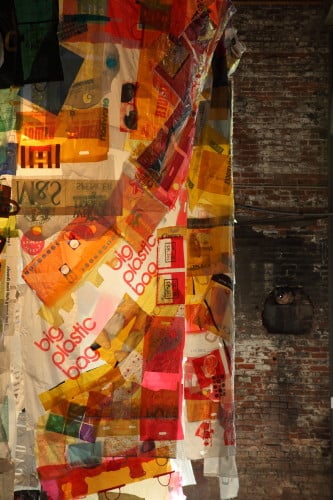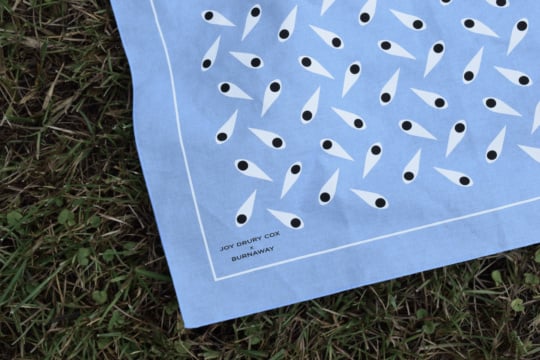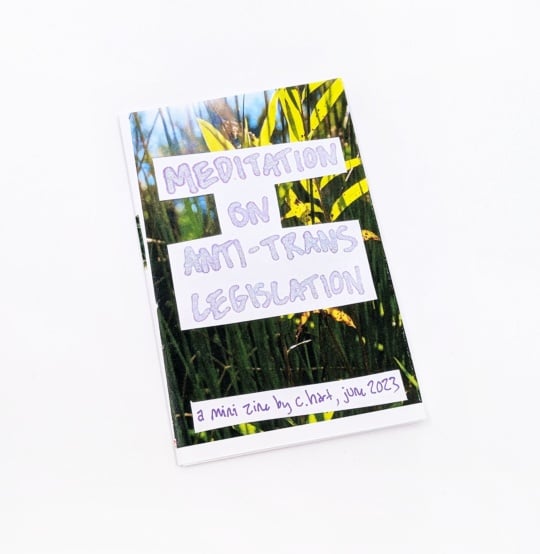
This spring, two exhibitions—“Second Nature: Artists Respond to Our Changing Environment,” on view at Barbara Archer Gallery at the Goat Farm Arts Center through May 17 and “One Word: Plastics” at Sandler Hudson Gallery through May 31—encourage viewers to consider humankind’s role in climate change and become more thoughtful stewards of the environment.
“Second Nature,” which was sparked by a request from the Atlanta chapter of the Nature Conservancy, includes works by 33 artists, who each in their own way highlight the issues affecting our world’s plant and animal species. The significantly smaller but no less moving “One Word: Plastics” show at Sandler Hudson features the work of several artists who reuse discarded plastic items—bags, bottle caps, etc.—to create art that speaks to the problem of our world’s incredible and unfortunate stash of trash.
Many of the works on display in “Second Nature” address the issue of endangered and extinct species. For example, the multimedia work Listed by Ruth Stanford acts as an inventory of U.S. vertebrates—mammals, birds, reptiles, amphibians, and fishes—on the endangered species list. More than 400 stained wood squares of varying sizes, each with its own set of eyes, are puzzled together, representing each species on the list. The flat look of the squares speaks to the flat, impersonal nature of the list, while the eyes—peering out from the wood as eyes peering out from a forest—allude to each unique life. In front of the work, a spotlight illuminates a podium—purposely designed to be wobbly—that holds a copy of the Endangered Species Act of 1973. Whoever stands here is met with those 400-plus sets of eyes.

Other examples highlight not just the threatened animal species but the development that’s to blame for its disappearance. For example, Tim Hunter’s Birds in Decline features silhouettes of birds painted onto asphalt and cement panels—the very materials associated with the development that’s responsible for the demise of these particular species. And Nikki Starz’s sculpture Gonzo Was a Muppet, Too, built partially of recycled materials, depicts the endangered Southern Cassowary, a unique bird native to Queensland, Australia, standing on a pile of red clay, bricks, and cement rocks (collected directly from the Goat Farm property) that represents the development destroying its habitat. (According to the artist, the Southern Cassowary plays an important role in the ecosystem by digesting fruit seeds that are then deposited via its excrement throughout the rainforest.)

Endangered and extinct plant species are also given love at the Goat Farm show. Peggy Cyphers’s Iowa Prairie Conversation pays homage to the many now-extinct plant species that once thrived on the American Prairie but have disappeared due to agricultural farming. Her cyanotypes feature images of centuries-old extinct plants she unearthed from the archives at the Grinnell College herbarium. By incorporating those plant images, she connects the meticulous cataloguing of 19th-century naturalists with her own artwork and the work of naturalists today.
Lastly, husband-and-wife team David Kaminsky and Betsy Cain, who live on the marsh in Savannah, Georgia, contribute pieces that highlight the threatened marsh grass in their area, whose tidal migration is obstructed by area docks. Kaminsky’s work, Marshgrass, Ossabaw Island, is a close-up photograph of the grass, while Cain’s Wrack Drawing #1 and Wrack Drawing #2 involve a completely different medium to depict the same grass: She used a woodcarving tool to peel back black oil paint from a white surface, creating the linear look of the reeds.
One of the environment’s greatest enemies is the ubiquitous plastic shopping bag, and L.A.-based Dianna Cohen, whose work is featured in both shows, has been using them as her primary material for 20 years. Suspended from Archer’s ceiling, her work Funnel is a cylindrical, hand-stitched patchwork of shopping bags whose shape evokes that of a tornado’s, alluding to the violent weather linked to climate change. Plus, the colorful images on the tornado of bags remind us how easy it is to be sucked into the shiny allure of consumerism.

Pam Longobardi’s work A Distant Mirror, on view at Sandler Hudson, is similarly focused on consumerism and also constructed of plastic—this time, found items like bottle caps and golf balls recovered from both the ocean and urban settings. The reused trash is pieced together to create the look of a regal old-fashioned mirror frame, though without any reflective glass. That way, instead of his or her own reflection, the viewer is met with the blank white gallery wall, flanked by the evidence of his or her own waste and consumerism.
Amanda Arnold is an Atlanta-based writer and editor whose pieces on travel, lifestyle, food, photography, and other topics have appeared in a variety of online and print publications, including Forbes.com, Forbes Travel Guide, and HowStuffWorks.







